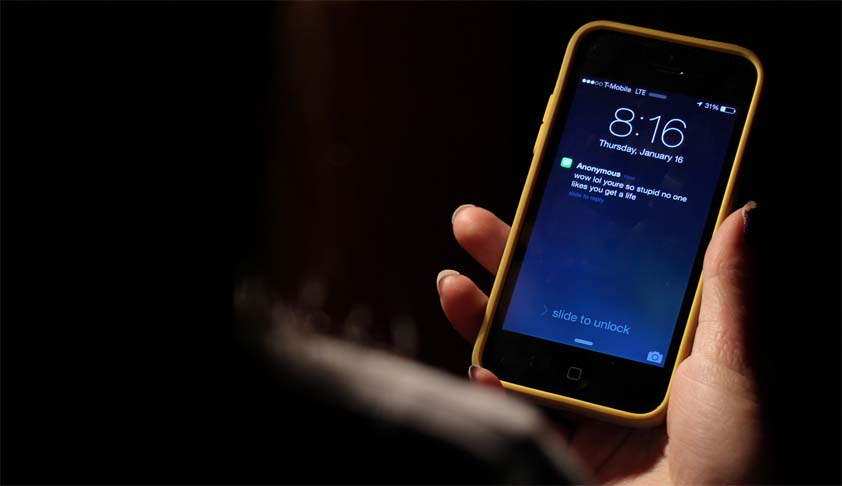Cyber bullying is a vice that should be stopped completely
Dr. V.V.L.N. Sastry
21 May 2016 6:41 PM IST
Cyber bullying is a premeditation and malicious antagonistic activity that is demonstrated by a perpetrator towards a victim (Hendricks, 2012). Many people spend more time texting and on the internet oriented devices and, therefore, they are culpable to be victimized by their friends, peer groups, activists in the name of self-adjudged common good and others who have malicious intent and have...
Cyber bullying is a premeditation and malicious antagonistic activity that is demonstrated by a perpetrator towards a victim (Hendricks, 2012). Many people spend more time texting and on the internet oriented devices and, therefore, they are culpable to be victimized by their friends, peer groups, activists in the name of self-adjudged common good and others who have malicious intent and have an intent on intimidating and harassing. The cyber bullies anonymously attack their victims by forging their information on various social sites to cover their tracks. Bullying has traditionally taken the form of aggressive acts that are repetitively perpetrated (Kowalski et al., 2014). With the introduction of computers and smart mobile devices, bullying has taken a new turn. The acts of cyberbullying have led to stress and pressure associated with being maligned by their peers or anonymous people. As a result, cyberbullying is a vice that should be stopped completely.
Cyberbullying has evolved from the use of text to the advanced use of various apps on smartphones that lead to the character assassination of the victims. More people today have access to the internet as compared to the last decade. Computers and other mobile devices have evolved greatly, and more information can be shared on the net than before. Cyberbullying got national attention in 2007 in USA after Megan, who was a teenager from Missouri, was hoaxed and repeatedly attacked online by her reportedly fictitious boyfriend and her friends (Mirsky & Omar, 2015). The perpetrators of the cyberbullying were the mother and sister to a classmate or Megan. Such instances have shown the extent to which society has sunk in terms of cyberbullying. A middle school student that targeted the principal and an algebra teacher reportedly created a website. It had threatening and uncouth statements about them. This kind of incidents are also quite common in India.
The digital age has enabled not only texts to be longer and accessed by many people but also pictures. Jessica Logan is a teen who committed suicide after nude pictures of her were posted on the internet and were circulated throughout among her fellow students in Cincinnati (Carpenter & Hubbard, 2014).
The digital age has brought about portable devices that can be carried around quite easily and used for any one's convenience. The mobile devices have evolved greatly to incorporate various features like cameras and apps that can instantly post any information on the social media that includes Google blogs, Yahoo groups, Facebook, Twitter among many other which have millions of users (Kowalski et al., 2012). Many apps have access to social media sites, which are linked to the camera, and pictures can be posted instantly without the use of a computer. Also, smartphones have led to a revolution in communication not only in using text messages and calls but also in using pictures taken at a specified time. Therefore, cyberbullying can bring on board many users who know the person and who can post negative comments about him or her. As such, one person can start the cyberbullying while bringing others into it. For example, malicious content can be posted about someone and everyone be able to see the content and even make comments such acts have led to undesirable affects which the bully may not be aware (Schneider et al., 2012). The stressful conditions that occur have often led to suicides or the victim withdrawing him or herself from his/her peers and society.
The abuse of computers have also given birth to a gamut of new age crimes in India that are addressed by the Information Technology Act, 2000 in India. The process of law to desired justice is a long driven process in India. Under the said circumstance, social sites should voluntarily educate, and encourage victims to report any user who posts malicious content that is not true, and ensure blocking such content should it surface on social media and other networking sites and walls.
Initiative should thus be taken to deal with the vice and prevent further accidents involving individuals. All social media sites including blogs should have a block feature and the victim’s requests to block such writings be obeyed by the respective administrative staff of social media sites. Otherwise,irrespective of any number of laws, bullies will find their way. Cyberbullying is an evil that has greatly affected most people and should be brought to a stop to prevent any undesirable acts like suicides, social withdrawal etc. taking place (Slonje et al., 2013).
References
Carpenter, L. M., & Hubbard, G. B. (2014). Cyberbullying: implications for the psychiatric nurse practitioner. Journal of child and adolescent psychiatric nursing, 27(3), 142-148.
Hendricks, L., Lumadue, R., & Waller, L. R. (2012). The evolution of bullying to cyber bullying: an overview of the best methods for implementing a cyber bullying preventive program. In National Forum Journal of Counseling and Addiction (Vol. 1, No. 1).
Kowalski, R. M., Giumetti, G. W., Schroeder, A. N., & Lattanner, M. R. (2014). Bullying in the digital age: A critical review and meta-analysis of cyberbullying research among youth. Psychological bulletin, 140(4), 1073.
Kowalski, R. M., Limber, S. P., & Agatston, P. W. (2012). Cyberbullying: Bullying in the digital age. John Wiley & Sons.
Mirsky, E. L., & Omar, H. A. (2015). Cyberbullying in adolescents: The prevalence of mental disorders and suicidal behavior. International Journal of Child and Adolescent Health, 8(1), 37.
Schneider, S. K., O'Donnell, L., Stueve, A., & Coulter, R. W. (2012). Cyberbullying, school bullying, and psychological distress: A regional census of high school students. American Journal of Public Health, 102(1), 171-177.
Slonje, R., Smith, P. K., & Frisén, A. (2013). The nature of cyberbullying, and strategies for prevention. Computers in Human Behavior, 29(1), 26-32.
Dr. V.V.L.N. Sastry is a Researcher in Law at Walden University, U.S.A.



